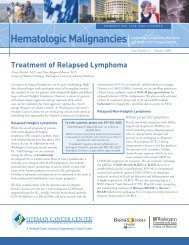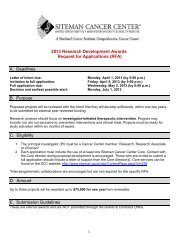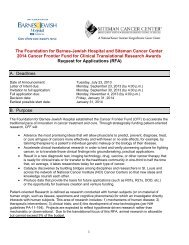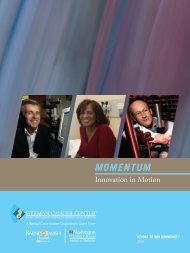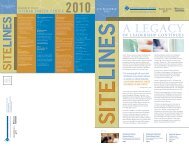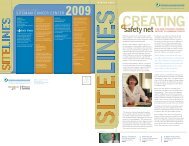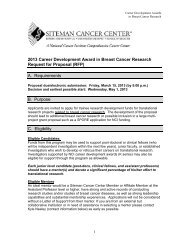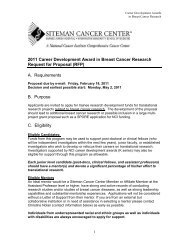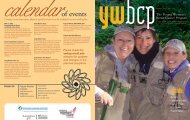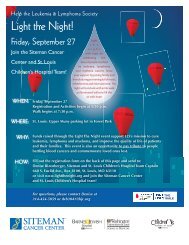Planting the Seeds of Prevention - Siteman Cancer Center
Planting the Seeds of Prevention - Siteman Cancer Center
Planting the Seeds of Prevention - Siteman Cancer Center
You also want an ePaper? Increase the reach of your titles
YUMPU automatically turns print PDFs into web optimized ePapers that Google loves.
Vetta Sanders Thompson, PhD, left, is a leading researcher in <strong>the</strong> area<br />
<strong>of</strong> racial identity and health care disparities. Her current work includes<br />
seeking <strong>the</strong> most effective ways to promote vaccination for human<br />
papillomavirus (HPV) in <strong>the</strong> African-American population.<br />
4 The Alvin J. <strong>Siteman</strong> <strong>Cancer</strong> <strong>Center</strong><br />
Schootman’s research also revealed a decline in disparity for overall<br />
mortality rates. In 1990, cancer deaths among African Americans were<br />
48 percent higher than in whites. By 2005, <strong>the</strong> disparity had decreased<br />
to 28 percent. The slow pace <strong>of</strong> this decrease means racial disparity in<br />
cancer deaths will probably continue for several decades unless more<br />
aggressive interventions are used, Schootman says. He also notes that<br />
disparity in mortality rates for colorectal cancer did not narrow, and<br />
<strong>the</strong> difference between <strong>the</strong> races in breast cancer mortality actually<br />
increased, again suggesting precise targets for prevention work.<br />
Vetta Sanders Thompson, PhD, is working to improve cervical cancer<br />
prevention efforts. Sanders Thompson, associate pr<strong>of</strong>essor <strong>of</strong> public<br />
health at Washington University’s George Warren Brown School <strong>of</strong> Social<br />
Work, is studying <strong>the</strong> social and cultural factors that influence African-<br />
American parents’ decisions about whe<strong>the</strong>r to have <strong>the</strong>ir daughters<br />
vaccinated against human papillomavirus (HPV), a known cause <strong>of</strong><br />
cervical cancer. After surveying attitudes and concerns in collaboration<br />
with community agencies, she hopes to produce communications that<br />
resonate with this population and improve public health.<br />
In <strong>the</strong> area <strong>of</strong> breast cancer, Donna Jeffe, PhD, research associate pr<strong>of</strong>essor and director<br />
<strong>of</strong> <strong>Siteman</strong>’s Health Behavior and Outreach Core, is conducting a longitudinal study <strong>of</strong><br />
quality-<strong>of</strong>-life measures among breast cancer survivors diagnosed at various stages, including<br />
ductal carcinoma in situ — a preinvasive cancer — and stages I and IIA invasive breast cancer.<br />
One piece <strong>of</strong> this large six-year study investigates patients’ perceptions <strong>of</strong> <strong>the</strong>ir risk for<br />
recurrence. Jeffe asks, “If <strong>the</strong>y underestimate <strong>the</strong>ir risk for recurrence, do <strong>the</strong>y stop followup<br />
care? If <strong>the</strong>y overestimate <strong>the</strong>ir risk, does <strong>the</strong>ir quality <strong>of</strong> life suffer from <strong>the</strong> attendant<br />
anxiety?” She aims to develop educational programs that help breast cancer patients interpret<br />
<strong>the</strong>ir risks appropriately so <strong>the</strong>y make wise choices concerning <strong>the</strong>ir health.<br />
Also aiming to change behavior, Ross Brownson, PhD, pr<strong>of</strong>essor <strong>of</strong> epidemiology and<br />
surgery, is studying evidence-based approaches to cancer prevention. “We know a lot about<br />
how to prevent cancer, but too <strong>of</strong>ten, what we know is not used,” he says. For example,<br />
Brownson heads a project exploring <strong>the</strong> best way to approach state lawmakers about cancer<br />
so <strong>the</strong>y take informed action to improve health policy. “What do <strong>the</strong>y remember, and what<br />
do <strong>the</strong>y act on — stories, data or something else?” he asks. In ano<strong>the</strong>r study, he is evaluating<br />
<strong>the</strong> decision-making process in state health departments to identify gaps in <strong>the</strong>ir use <strong>of</strong><br />
scientific evidence.<br />
The work <strong>of</strong> Brownson and o<strong>the</strong>r cancer-prevention experts at <strong>Siteman</strong> dramatically<br />
expands <strong>the</strong> cancer center’s reach beyond individuals directly affected by a cancer diagnosis.<br />
By precisely identifying populations, customizing messages and rigorously defining best<br />
practices, <strong>the</strong>se researchers are helping entire communities avoid cancer.



